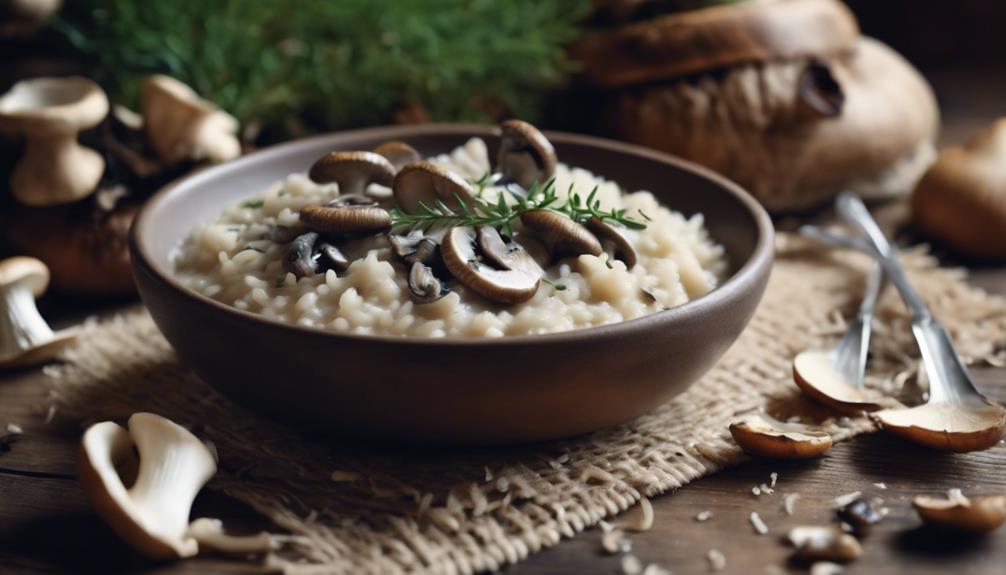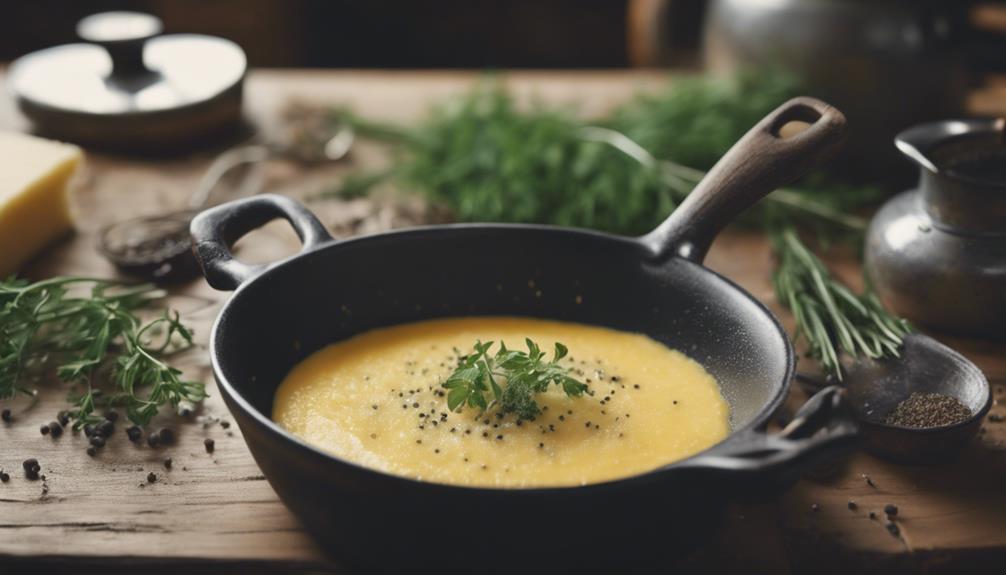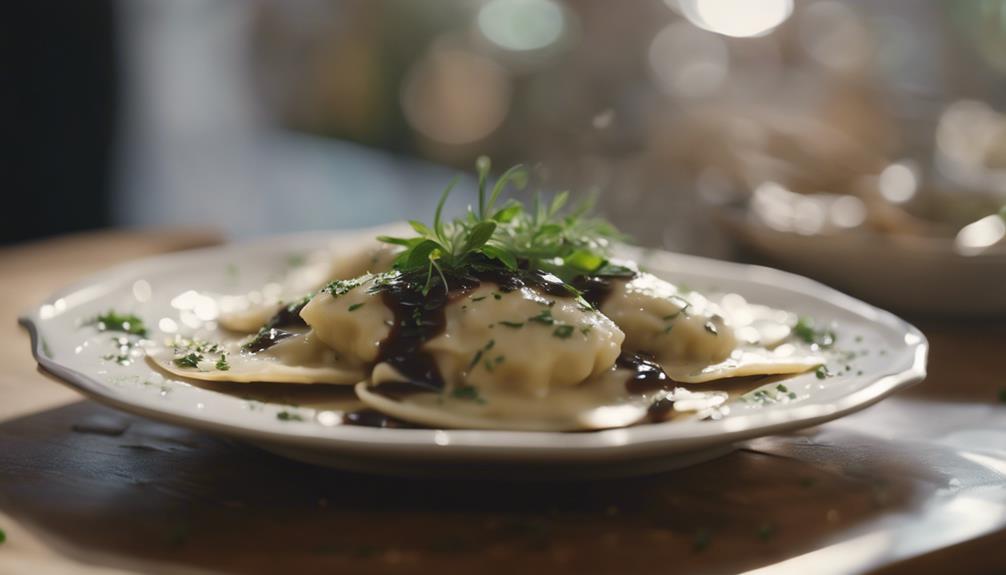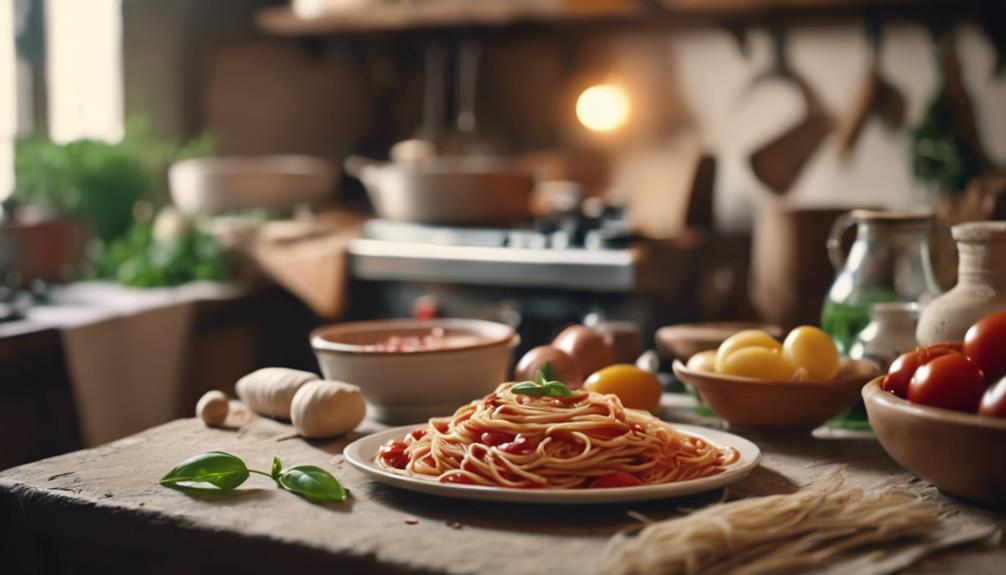Indulge in the rich flavors of Mushroom Risotto, a creamy Italian classic that offers a velvety texture and a flavorful taste profile. Explore the use of Arborio rice, sautéed onions, garlic, and a variety of mushrooms for an earthy essence. Enhance the dish with Parmesan cheese and dried porcini mushrooms for a savory umami depth. Finish by drizzling White Truffle Oil and garnishing with parsley for a luxurious touch. This dish can be served as a main or side dish, and pairs perfectly with white wine. Any leftovers can be used to make crispy risotto cakes or frozen for later enjoyment. Experience the art of creating this delicious meal for an authentic Italian culinary experience.
Key Takeaways
- Use Arborio rice for creamy texture and richness.
- Sauté onions and garlic for aromatic base.
- Incorporate various mushroom types for depth of flavor.
- Enhance with Parmesan cheese and herbs for complexity.
- Finish with white wine and truffle oil for luxurious touch.
Mushroom Risotto Recipe
If you're craving a creamy and flavorful Italian dish, try making a delicious mushroom risotto at home. This classic dish features Arborio rice, a short-grain rice that releases starch to create a rich and creamy texture.
To start, sauté onions and garlic in olive oil until fragrant, then add sliced mushrooms and cook until golden brown. Next, add the Arborio rice and stir until coated with oil. Gradually pour in hot broth, a ladle at a time, stirring constantly to allow the rice to absorb the liquid and release its starch, resulting in a creamy consistency.
Finish off the dish by stirring in grated cheese for added richness. The combination of earthy mushrooms, savory onions, and aromatic garlic provides a depth of flavor that pairs perfectly with the creamy Arborio rice.
Once prepared, this mushroom risotto can be enjoyed as a comforting main course or a decadent side dish, perfect for any occasion.
Ingredients for Risotto
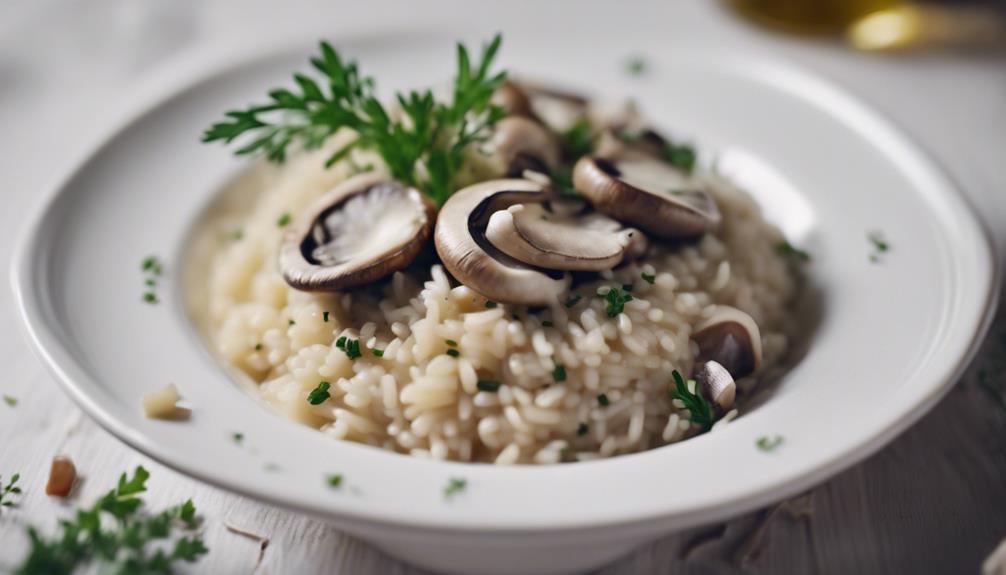
Consider gathering Arborio rice, mushrooms, onions, garlic, chicken or vegetable broth, Parmesan cheese, white wine, and seasonings for your mushroom risotto recipe. Each ingredient plays an essential role in creating the rich and creamy texture that characterizes this classic Italian dish. The Arborio rice, known for its high starch content, absorbs the flavorful chicken broth during cooking, releasing a velvety creaminess that envelops each grain. Mushrooms, whether Portobello, Cremini, Shiitake, or Chanterelles, contribute earthy flavors and a meaty texture to the dish. Onions and garlic provide a fragrant base, while Parmesan cheese enhances the umami notes. The addition of white wine adds a subtle acidity that elevates the overall taste profile of the risotto. To help you visualize the key ingredients needed for your mushroom risotto, here is a breakdown:
| Ingredients | Description |
|---|---|
| Arborio rice | High-starch short grain rice that creates a creamy texture. |
| Mushrooms | Various types like Portobello, Cremini, Shiitake, or Chanterelles for depth of flavor. |
| Onion/Garlic | Aromatic base for the dish. |
| Chicken broth | Provides savory liquid for cooking the rice. |
| White wine | Adds acidity and flavor complexity. |
Cooking the Mushrooms
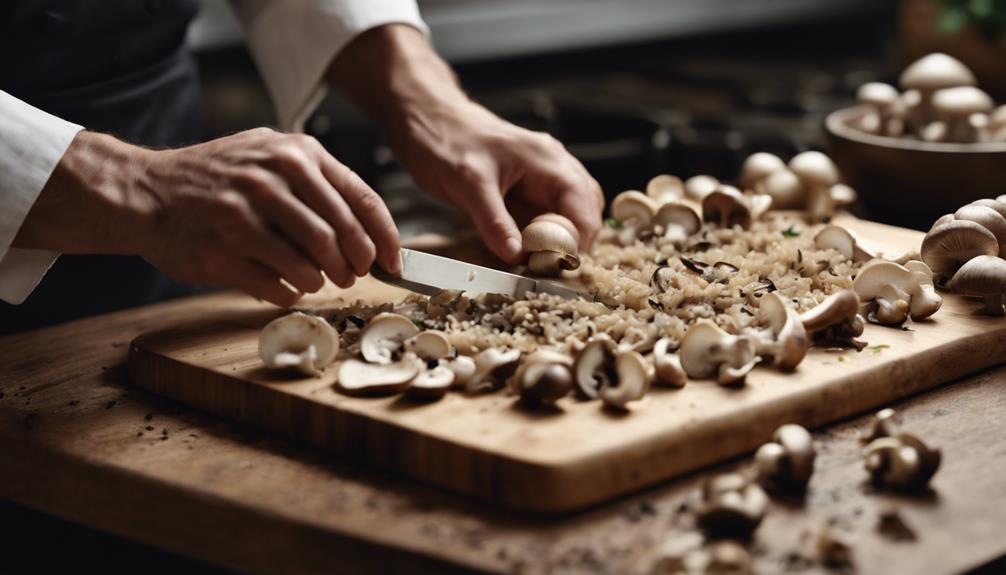
To cook the mushrooms for your mushroom risotto, start by gently cleaning and sautéing them in a skillet with garlic and oil until soft. This process allows the mushrooms to release their natural juices and intensify their flavors as the water evaporates.
Different varieties such as white, Cremini, Shiitake, Portobello, or Chanterelles can be used to provide unique tastes and textures to your dish. For a more intense and earthy flavor profile, consider experimenting with Porcini mushrooms. These rich and flavorful mushrooms can elevate your risotto to new heights.
Adding the cooked mushrooms to the risotto halfway through the cooking process allows the dish to absorb the rich mushroom flavors. This infusion of earthy tones creates a depth of taste that's characteristic of a well-prepared mushroom risotto.
Making the Risotto Base
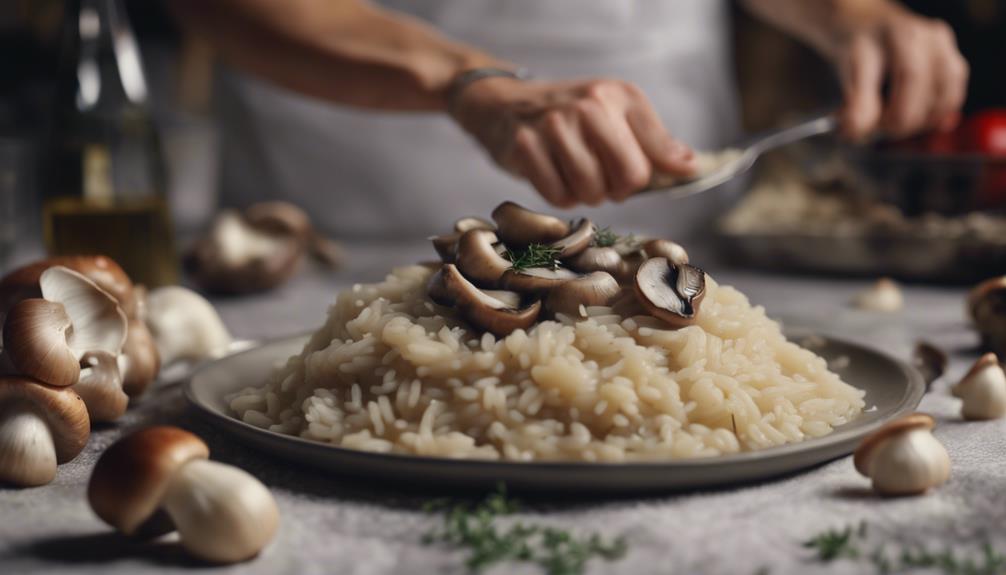
To make the risotto base, start by sautéing onions and garlic in a pan until fragrant.
Then, toast the rice in oil to enhance its nutty flavor.
Gradually add warm broth to the rice, stirring continuously to release starch and achieve a creamy consistency.
Sauté Onions and Garlic
Begin by heating olive oil in a large skillet over medium heat. When the oil is shimmering, add finely chopped onions and minced garlic to the skillet. Sauté the onions and garlic until they turn translucent, releasing their aromatic flavors.
The onions contribute a sweet undertone, while the garlic adds depth to the risotto, forming a flavorful base for the dish. This combination of sautéed onions and garlic establishes a savory foundation that will enhance the overall taste and richness of the mushroom risotto.
Properly cooked onions and garlic are essential in creating a balanced flavor profile for the risotto. The slow cooking process allows the onions to caramelize slightly, intensifying their sweetness, while the garlic infuses the oil with its pungent essence. Together, they provide a robust base that sets the stage for the next steps in making this creamy Italian classic.
Toast the Rice
Start by heating olive oil in a large skillet to prepare the rice for your flavorful mushroom risotto. Toasting the rice grains in olive oil or butter is an essential step in creating the perfect risotto base. This process helps enhance the nutty flavor of the dish and guarantees that each grain cooks evenly. By adding a protective barrier around the rice grains, toasting allows them to absorb liquid gradually, resulting in a creamy yet firm texture in the final dish. It also prevents the rice from becoming mushy or sticky, maintaining a rich and slightly crispy exterior on the grains. The golden color and depth of flavor developed during toasting set the stage for a well-textured mushroom risotto. Remember to stir the rice continuously over medium heat to achieve an even toasting. Below is a table highlighting the importance of toasting the rice:
| Benefits of Toasting Rice in Risotto |
|---|
| Enhances nutty flavor |
| Ensures even cooking |
| Prevents mushiness |
Add Warm Broth Gradually
Gradually pour in warm broth as you stir the rice to develop the creamy base of your mushroom risotto. The gradual addition of warm broth is essential in creating the signature creamy texture of this Italian classic.
As you stir the rice, the warm broth allows the grains to slowly absorb the liquid, releasing starch and resulting in a velvety consistency. This methodical process not only prevents the rice from sticking but also guarantees even cooking throughout. By adding the warm broth slowly, you're allowing the flavors to develop and merge, enhancing the overall richness of the dish.
The velvety texture and creamy mouthfeel of a well-prepared mushroom risotto are achieved through the patient addition of warm broth. It's vital to maintain a slightly firm texture while achieving that desired creamy consistency.
The methodical incorporation of warm broth not only contributes to the overall flavors but also plays a pivotal role in creating the luscious and creamy finish that defines a perfect mushroom risotto.
Adding Flavorful Elements
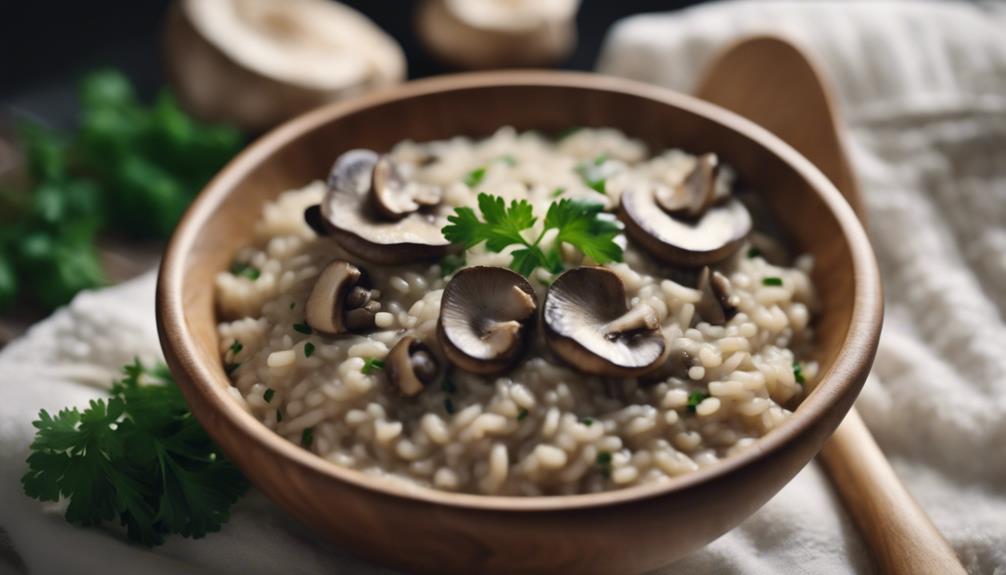
To enhance the flavors of your mushroom risotto, consider infusing aromatic herbs like thyme and rosemary for a fragrant touch.
Elevate the taste profile by incorporating a splash of white wine during the cooking process.
Boost the umami factor by using a combination of Portobello, Cremini, and reconstituted porcini mushrooms in your dish.
Infusing Aromatic Herbs
Enhance the flavor profile of your mushroom risotto by infusing aromatic herbs like thyme, rosemary, or sage. These fragrant additions not only elevate the taste of your dish but also bring a touch of traditional Italian cuisine to your kitchen. As the herbs are heated during the cooking process, they release essential oils and flavors that blend harmoniously with the savory notes of the risotto.
Incorporating fresh herbs like thyme, rosemary, or sage adds depth and complexity to your mushroom risotto, creating a rich and satisfying flavor profile. The infusion of these aromatic herbs imparts a delightful fragrance that enhances the overall dining experience.
In Italian cuisine, the use of aromatic herbs is a common practice to intensify the taste of classic dishes such as risotto. By experimenting with different combinations of herbs, you can personalize your mushroom risotto and create a unique culinary masterpiece that delights the senses.
Enhancing With Wine
Consider incorporating wine into your mushroom risotto to add depth and complexity to its flavor profile. The importance of acidity in wine plays a vital role in balancing the richness of the dish, resulting in a well-rounded taste that tantalizes the palate.
While white wine is a common choice for mushroom risotto, don't hesitate to experiment with red wine to introduce a different twist to the dish. The alcohol in the wine evaporates during cooking, leaving behind a subtle essence that enhances the overall flavor experience.
Adding the wine before the broth allows the rice to soak up the intricate flavors, contributing to a more nuanced and aromatic risotto that's sure to impress your taste buds.
Incorporating Umami-Rich Ingredients
Umami-rich ingredients like mushrooms, Parmesan cheese, and dried porcini mushrooms play an essential role in elevating the savory flavor profile of mushroom risotto.
Mushrooms aren't only a key component in this dish but also bring a meaty texture and earthy taste, contributing to a comforting culinary experience.
The addition of Parmesan cheese introduces a salty and nutty essence, perfectly complementing the umami notes from the mushrooms.
Additionally, dried porcini mushrooms, once reconstituted in warm broth, infuse a profound and rich umami flavor into the risotto, enhancing its overall complexity.
The amalgamation of these umami-rich elements results in a creamy, savory dish that's deeply satisfying to the taste buds.
The combination of textures and flavors creates a harmonious blend, making mushroom risotto a classic Italian favorite cherished for its comforting and deeply savory essence.
Finishing Touches
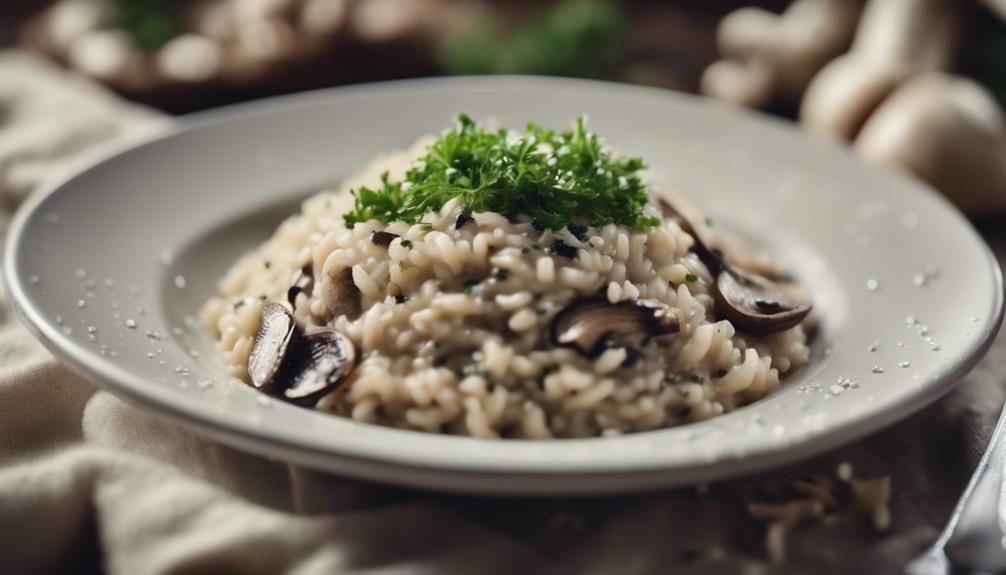
To complete your mushroom risotto, add a luxurious touch by drizzling White Truffle Oil as a finishing touch. This aromatic oil enhances the earthy flavors of the dish, elevating its overall taste profile.
Additionally, garnish your mushroom risotto with chopped parsley to introduce a fresh and herbaceous element that complements the richness of the dish.
Consider pairing your finished risotto with a glass of dry white wine, as the crisp acidity and subtle fruitiness of the wine will harmonize with the creamy texture and earthy notes of the risotto.
For added richness, sprinkle some grated Parmesan on top before serving to further enhance the flavors and presentation of this classic Italian dish. These finishing touches not only add depth to the dish but also contribute to a visually appealing presentation that will impress your guests.
Serving Suggestions
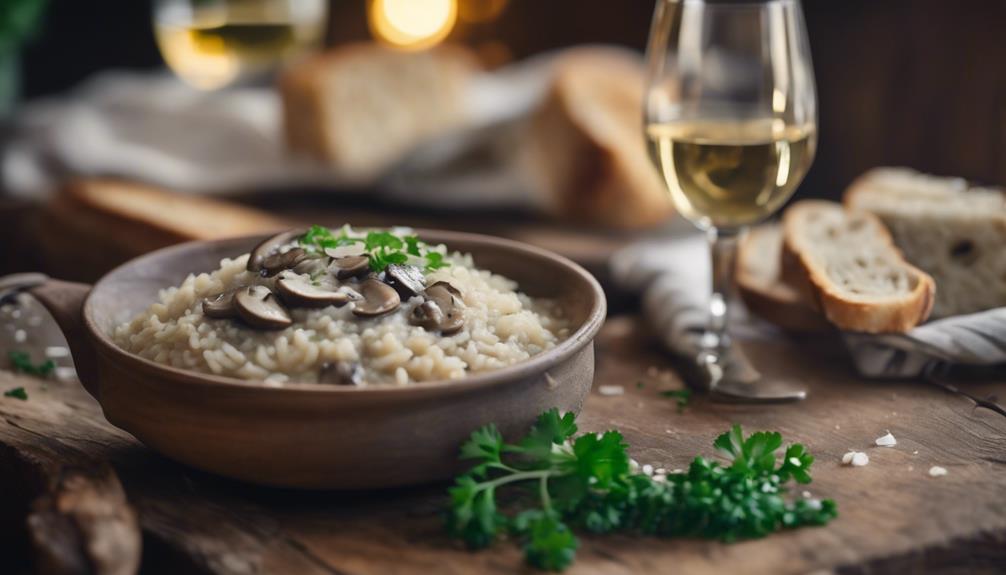
To present your mushroom risotto in an appealing manner, carefully consider the serving suggestions that complement its rich and flavorful profile. Here are three serving suggestions that will enhance the experience of enjoying this creamy Italian classic:
- Main Dish Versatility:
Serve the mushroom risotto as a main dish, allowing its creamy texture and flavorful essence to take center stage. Pair it with a side of roasted chicken to create a satisfying and well-rounded meal that will delight your taste buds.
- Italian Menu Highlight:
Elevate your Italian menu by featuring the mushroom risotto as a star dish. Its comforting and rich flavors make it a perfect addition to any Italian-themed meal, offering a taste of traditional flavors with a modern twist.
- Side Dish Perfection:
Use the mushroom risotto as a side dish to complement roast chicken, pork, or beef entrees. Its creamy texture and flavorful profile will enhance the overall dining experience, making it a versatile and delicious accompaniment to various main courses.
Storage and Reheating
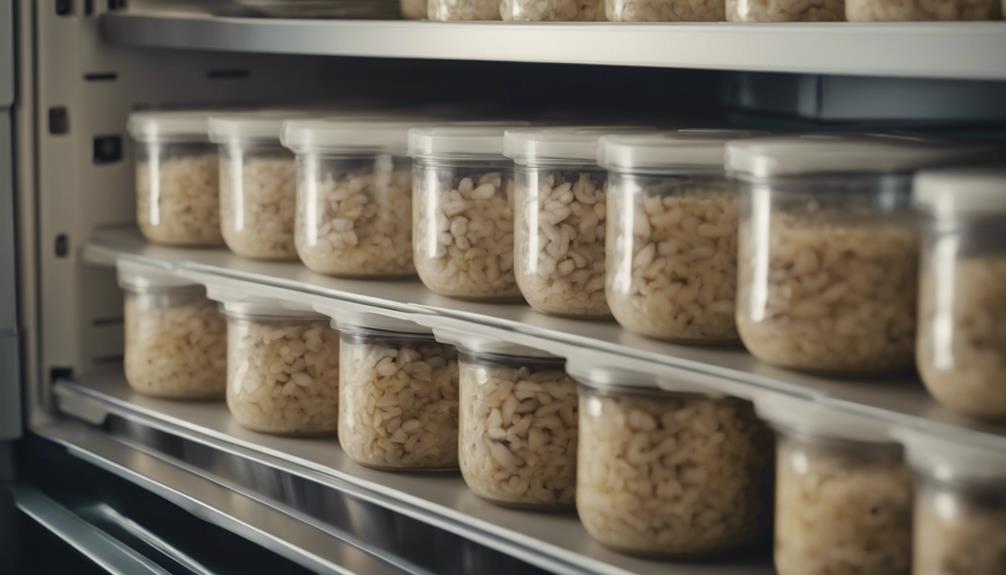
How long can you store leftover mushroom risotto in the fridge? Leftover mushroom risotto can be stored in an airtight container in the fridge for up to three days.
When reheated, the risotto may lose some of its initial creaminess, but fear not, as it can be repurposed into delectable patties by forming them and frying into crispy risotto cakes.
If you wish to extend its shelf life, freezing mushroom risotto is an option. Store it in an airtight container in the freezer for up to three months. For the best results, thaw the risotto overnight in the fridge before reheating.
Be aware that freezing the risotto may slightly alter its texture upon reheating. However, when properly reheated, the mushroom risotto should still maintain a creamy consistency and retain its rich flavor profile.
Whether enjoying it fresh, as leftovers, or from the freezer, your mushroom risotto can be a delightful meal with a little care in storage and reheating.
Frequently Asked Questions
Why Is Risotto a Traditional Italian Dish?
Risotto is a traditional Italian dish due to its creamy texture achieved by slowly adding warm broth to starchy rice, allowing grains to release starch. The method creates a rich consistency, showcasing Italian culinary artistry.
Why Is Risotto so Creamy?
To achieve that velvety creaminess, you slowly release Arborio rice's starch by stirring in warm broth. Adding butter, cheese, and wine enriches the texture. Sautéed mushrooms, onions, and garlic deepen the flavor. Finish with more cheese or butter for ultimate richness.
What Kind of Risotto Do They Use in Italy?
In Italy, they use Arborio, Carnaroli, or Vialone Nano rice for risotto. Each type offers distinct textures and flavors. The choice of rice greatly impacts the creamy consistency of the dish, absorbing flavors perfectly.
What Is the Famous Risotto in Italy?
So, you wanna know the famous risotto in Italy? Well, brace yourself for the creamy, dreamy delight of traditional risotto! Slow-cooked Arborio rice, rich broth, and a whole lotta love. Bellissimo!
Can Mushroom Risotto and Mushroom Ravioli be Considered as Similar Italian Dishes?
Yes, mushroom risotto and mushroom ravioli can be considered as similar Italian dishes due to their use of mushrooms as the main ingredient. Both dishes offer a rich and savory flavor, especially when paired with a creamy parmesan cream sauce. Whether you prefer a creamy rice dish or stuffed pasta, both options are delightful.
Conclusion
To sum up, mushroom risotto is a beloved Italian classic that never fails to impress.
Did you know that risotto is one of the top ten most searched for recipes on the internet?
With its creamy texture and rich flavor, it's no wonder why this dish is a favorite among food enthusiasts.
So why not try your hand at making this delicious dish at home and impress your family and friends with your culinary skills?
